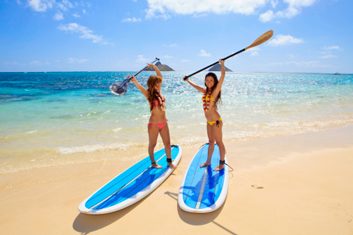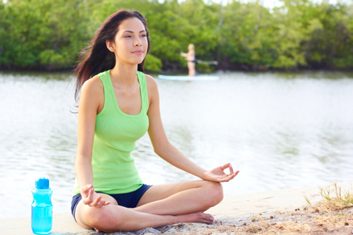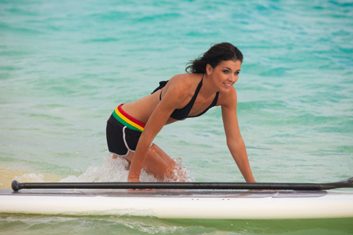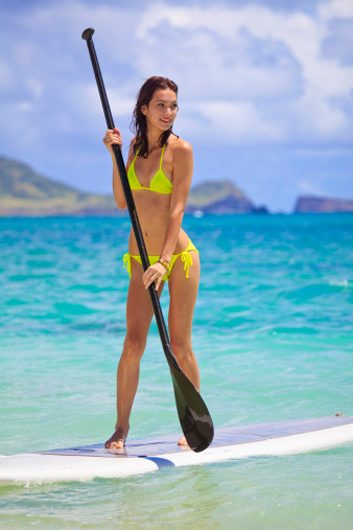
A popular celeb sport
When Michelle McChristie arrived at Algonquin Provincial Park in central Ontario in 2010 with a stand-up paddleboard strapped to the roof of her car, she got more than a few raised eyebrows and laughs from people who thought she and her family were surfers who were seriously lost. “Even when I explained-‘You stand up on the board on the water and paddle’-people still seemed puzzled,” remembers McChristie, who lives in Thunder Bay, Ont. That was three years ago, though.
Today, the sight of someone stand-up paddleboarding (SUP) is more likely to draw cries of, “Hey, I want to try that!” The sport, which originated in Hawaii in the 1950s, is becoming more and more popular, fuelled by word of mouth and paparazzi shots of fit celebs like Jennifer Garner and Matthew McConaughey SUPing at tropical resorts.

Sculpt a strong core
Paddle Canada, the national paddling sports association (which covers kayaking, canoeing and SUP), reports that the number of participants taking courses more than doubled between 2011 and 2012.
No wonder. “It’s relatively simple to learn,” says Ben Schram, a physiotherapist studying SUP at the faculty of health science and medicine at Bond University in Australia. Plus, he says, it’s a killer workout, particularly for the core muscles; it’s easy on the joints; and it improves balance. Calorie-burning estimates are hard to come by because it’s a new sport, but a 150-lb. woman rowing or canoeing at a moderate pace is estimated to burn 475 calories per hour. Most of all, though, SUP is fun.

Meditative benefits
For 38-year-old McChristie, who works for the Ontario Ministry of the Environment and also publishes a regional outdoor magazine, the fun started in the summer of 2010, when she was at a meeting at a lodge on Lake Superior and saw staffers of a local paddling centre SUPing in the waves at the mouth of a river. When an instructor encouraged her to give it a try, she kicked off her running shoes and went out. “I like the challenge of learning a new way to paddle, and the perspective of standing up rather than sitting down,” says McChristie, who has done a fair amount of canoeing and kayaking. She’s noticed stronger core muscles, but for her, the real benefit is the mental-health payoff. “The calmness, the rhythm of the waves and the water and the paddling…. It’s really meditative,” she says.
That same summer, she and her husband, Darren, bought a board, and their kids-Sarah and Nathan, who are now age seven and nine-began to take turns on the board with their parents, first just standing up to balance and later using a paddle.
Last summer, McChristie took a SUP instructor course in Thunder Bay so she could improve her own skills and introduce others to the sport as well. “Being out on the board is a healthy way to escape the stress of a typical day,” she says. From June to September, she tries to get out for 90 minutes about once a week, often on a small lake where her parents live, near Thunder Bay, but increasingly on the bigger swells of Lake Superior, too. “My fibreglass sea kayak is hard to manoeuvre on and off the car roof rack on my own,” she says. “But it’s no problem for me to throw on my board [boards weigh only 20 to 25 pounds] and take off to the lake for a paddle.”

Build strength
For Jessica Rando, SUP is a natural extension of her love of various paddling sports. The Mississauga, Ont.-based fitness trainer first tried the sport in 2010 while she was on her honeymoon in Hawaii, and loved how it complemented her 15 years of experience with sprint canoeing and dragon boating in national and international races. “SUP is versatile: You can paddle on lakes, rivers or oceans; waves or no waves. There was room for me to grow as a paddler in different water conditions, but it was also really easy to pick up and learn,” says Rando, 29. “I was addicted the second I tried it, and I think that’s how it is for a lot of people.”
Today she runs SUP lessons, clinics, group programs and workouts in various communities on Lake Ontario through her company, NuMe Fitness; she has taught kids as young as five and adults into their early 70s. That means from May to September she’s on the water for up to seven hours a day. She has found that SUP helped her become more balanced in her strength, since she needs to paddle on both the left and right rather than just one side as she does for canoe or dragon-boat races; she has also developed endurance, since she was used to short sprint races. Not surprisingly, she has been placing in the top spots in competitive SUP races both in Ontario and across the U.S.
SUP races, you say? There are two popular types: a “downwinder,” where you race from point A to point B with the wind at your back; and a “battle of the paddle,” where you race in a loop, navigating around buoys, and often have a run on the beach at the start or finish. Distances range from four to 20 kilometres. “Anyone can race!” Rando insists. “It’s a great community of people, and you get all ages and abilities. You’ll be welcomed with open arms.”

A great cardio workout
Kelly Miller of Bowen Island, B.C., had no experience with paddle sports, unlike McChristie and Rando. But it was still love at first sight when she saw it done in the summer of 2011. “A friend showed me how to use one, and I jumped on right away. It was amazing, like walking on water,” she says. “We were out on the ocean on this beautiful calm night and watched the sun set. I was hooked.”
Miller, 24, a technician at a vet clinic and at a tattoo parlour, soon bought her own board. Now she SUPs along the beaches of Bowen Island nearly year-round, throwing a sweater on over her half-wetsuit and wearing neoprene booties in cold weather. In the summer she goes out at least three times a week and it’s usually a social time, too-she and 10 to 15 friends, including her boyfriend, Calvin, take turns using five boards. Her dog, River, a 45-lb. Nova Scotia duck tolling retriever, hitches a ride as well. “She’s been coming on my motor scooter with me since she was a puppy, so she’s used to the idea of staying still on something that’s mobile,” says Miller. “She just sits there and watches the view while I do all the work!”
She has noticed the benefits: “Besides your core strength, you use your arms for propelling yourself, and you get nice strong legs from staying balanced because there are waves from speedboats ripping by. It’s good cardio, too, because half the time my friends and I are playing around and racing. It’s just the perfect workout.”
Next up for Miller: SUP yoga-yes, yoga on your board, in the water. A handful of classes are offered across Canada, mainly in B.C. and Ontario.
Related:
• Stand-up paddlebaording: How to get started
• 7 exciting water sports you haven’t tried
• The ultimate water workout
